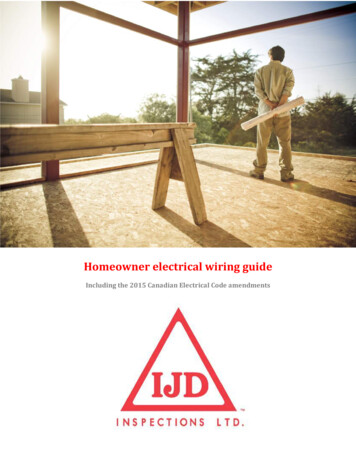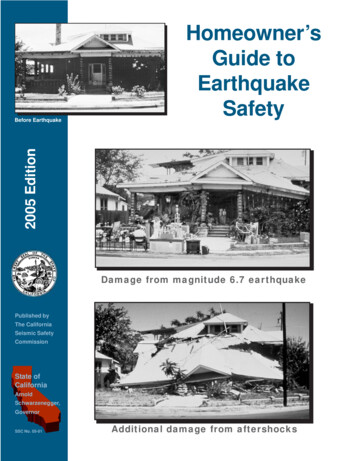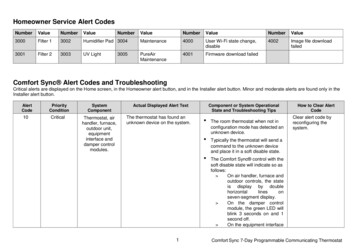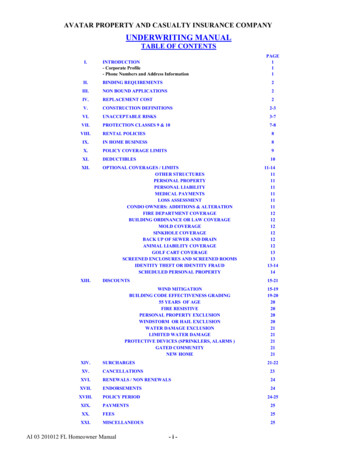
Transcription
A HOMEOWNER'S GUIDETO BECOMING WATER WISE
THE JOY OF WATERA Homeowner’s Guide to Becoming Water WiseBy Jennifer Roberts, Annabeth McCall, and Miriam BelblidiaAcknowledgements:Water Works would like to thank the members of theWater Wise NOLA Team, including Bayou Land RC&D,Dana Brown & Associates, Global Green USA, and Hilairie Schackai fortheir input and collaboration on this book.The preparation of The Joy of Water would not have been possiblewithout significant contributions by Matthias Helfen, Annabeth McCall, andJulia Strasser. Photos have been provided by Matthias Helfen, Sami Khalil,Jennifer Roberts, and Julia Strasser. The booklet was designed by Liz Cooke.Funding for the first edition of The Joy of Water was originallymade possible by a grant from the Greater New Orleans Foundation,administered by Global Green USA. We are proud to release the secondedition of The Joy of Water, and hope it will continue to inspire citizensto play an active role in water management. 2015, Louisiana Water WorksAll rights reserved. No part of this publication may be reproduced,stored in a retrieval system, or transmitted in any form or by any meanswithout prior written permission of the publisher.For permission, please contact:Water Works, L3C4035 Washington Ave.New Orleans, LA 70125info@waterworksla.com
TABLE OF CONTENTSI. Introduction1.2.Recipes for Water ManagementVocabulary: Learn the lingoII. Background1.2.3.4.Overview of Water Management in Our RegionWhy Worry About Stormwater: Quality & QuantityGood Practices: Letting Plants & Soil Work for YouThe Cumulative Effect of Small-Scale MeasuresIII. Getting Started1.2.3.Assessing Your PropertyCleaning Storm DrainsManaging Materials on SiteIV. Home Projects1.2.3.4.5.Disconnect DownspoutsPlanter BoxRain BarrelGravel TrenchRain GardenV. Caring for Your Community1.2.3.Get OrganizedReport Problem AreasBe Engaged
I. INTR ODUCTIO N
Recipes for water managementThe Joy of Water is designed to provide an easy guide to managingwater on residential property. Inspired by cookbooks, with theirstep-by-step instructions for preparing meals at home, this guidelays out a variety of “recipes” you can use on your property toreduce water pollution and small-scale flooding. It is designedto allow everyone to understand steps you can personally take toimprove water management in our region.The water management projects detailed here have been testedto ensure that the installation and maintenance requirementscan be completed by a committed homeowner in an afternoonor over a weekend. These are small-scale measures that you caninstall and maintain on your own. However, each individual hasdifferent abilities, resources, and levels of experience; you mayfeel the need to enlist help or hire professionals to perform theselection, design, and/or installation.This guide provides a variety of options, depending on time, resources, and property conditions. Your steps towards becomingWater Wise include:Getting Started: begin by understanding how water flows on yourproperty, how this water connects with the larger drainage system,and potential sources of pollutionHome Projects: ranging from simple downspout disconnections torain gardens, all of which can help slow, hold, and allow water to infiltrate into the groundCaring for Your Community: additional measures you can take,including expanding efforts in your neighborhood and becoming aWater Wise champion for better water management practices acrossthe cityTogether, all of these measures will help us become more awareof the value of water and the role we each play in making sureour water is clean and safe!5
VOCA BU LA RYLearn the lingoBioretention: utilizes soils andplants to remove pollutants fromstormwater runoffPervious (Permeable): allows waterto be absorbed into or through thesurfaceDownspout: pipe that directs stormwater runoff from the roof of a houseto the groundPlanter Box: a bioretention structurecomprised of plants, soil, gravel, andsand that can receive rainwater froma downspoutFiltration: the process by whichplants help absorb pollutionRain Barrel: a catchment systemthat collects runoff from a roof forreuseGravel Trench (French Drain): along, narrow, gravel-filled ditch thatcatches and treats stormwater runoffRain Garden: a planted depressionthat allows rainwater runoff fromimpervious urban areas like roofs,driveways, walkways and compactedlawn areas to be absorbed into theearthGreen Infrastructure: practices thatuse or mimic natural processes tosoak up and hold waterHydrology: the way water movesover the land and through the groundStormwater Best ManagementPractices (BMPs): techniques, measures or structural controls used tomanage the quantity and improve thequality of stormwater runoffInfiltration: the process by which water is soaked into the soil, balancingthe water tableImpervious (Non-permeable): doesnot allow water to be absorbed into orthrough the surfaceStormwater runoff: rainwater thatdoes not soak into the ground butflows over impervious areas or areasalready saturated with waterLow Impact Development (LID): astormwater management and landdevelopment strategy that works withnature to manage stormwater asclose to the source as possible6
II. BAC KGROUND
UNTREATED STORMWATER1.Overview of Water Management in our RegionThe Greater New Orleans region is defined by our relationshipwith water, which brings economic and recreational opportunities.However, small-scale flooding from rainfall can cause damageto property and stormwater runoff carries pollution into oursurrounding water bodies. We receive an average of 64 inches ofrain every year and due to the topography of our land, much ofthis untreated stormwater must be pumped, into our surroundingwater bodies, such as Lake Pontchartrain. When our drainagesystem of pipes, canals, and pumps is overwhelmed by excessiverainfall, water can back up and cause localized flooding.Green infrastructure and low impact development allowindividuals to actively help reduce localized flooding andpollution. Implementing measures that slow water down, holdit temporarily, allow plants to filter out pollutants, and infiltratewater back into the soil provide direct benefits to our homes andcity. Such approaches reduce the amount of stormwater trying toenter into the city’s system of pipes until after the peak rains havepassed, which reduces the frequency of street flooding duringsmall-scale storm events and improves water quality in LakePontchartrain and other surrounding water bodies.8
POLLUTES OUR LAKES2.Why Worry About Stormwater: Quality & QuantityStormwater picks up pollutants, such as trash, dirt, road grime, oil,pesticides, fertilizers, and metals, and pulls them into our drainagesystem. These hitchhiking pollutants are then pumped untreatedinto our surrounding water bodies, degrading the quality of ournatural water resources. We rely on our surrounding water bodiesfor fishing and recreation, so allowing pollution to run into ourlakes and rivers affects our health and quality of life. The amountof stormwater and pollutants released into local water bodies isminimized when stormwater is retained and treated using greeninfrastructure and low impact development.Measures that slow water down, hold it, and allow it to soak intothe ground can also help protect against small scale flooding,when heavy rainfall overwhelms our drainage infrastructure.While these measures may not be able to keep up with all therainfall we receive in Southeast Louisiana, they can help easethe burden on our system of pipes and canals when used widelythroughout our neighborhoods.9
MINIMIZ E C ONC RETEMAXIMIZ E GREEN SPACE3.Good Practices: Letting Plants& Soil Work for YouPlants and soil may not look active butthey are work horses. Gardens andlawns can be quite effective at removing pollutants: soil traps pollutants andplant roots break down pollutants intofood or fertilizer. For this reason, it is important to minimize the amount of impervious (non-permeable) area on yourproperty. Impervious areas, such as yourhouse’s roof and concrete driveways, donot allow water to be absorbed into theground. Avoiding unnecessary pavingon your property and allowing for areaswhich can capture runoff from yourroof are good practices when becomingWater Wise.10REMEMBER:In SoutheastLouisiana, we alsoface tropical stormsand hurricanes.These small scalemeasures are notintended to reduceour risk of floodingand pollution fromlarger storm events.The benefits ofgreen infrastructurecome in dealingwith the rainfall weget during smallerevents throughoutthe year.
NON-PERMEABLE SURFACESIN CREASE FLO ODI NG4.The Cumulative Effect of Small-scale MeasuresOn an individual property, the impact of green infrastructureand low impact development on water quality and quantity maybe small, but cumulatively, the benefits can be significant whenmany people take these measures across their neighborhoods.Most importantly, individual measures help raise awarenessabout the importance of reducing stormwater runoff and pollution.Some of the major benefits of green infrastructure include: Less stormwater leaves the property Stormwater can be captured, stored and reused forirrigation More water is absorbed into the ground to rechargeour aquifer (groundwater) Less pollutants go to our canals, bayous, lakes, estuaries and wetlands11
III. GETTING STARTED
BECOMING WATER WISEBEG INS AT HO ME1.Assessing Your Property: Know Where WaterEnters & LeavesThe following process will help you evaluate your property toselect the appropriate water management measure and bestlocation for this measure. You should first assess your property toidentify potential pollutant sources and to identify existing waterdrainage and runoff patterns. Before jumping into constructionany measures, it is critical to know where the water goes whenit falls on your lot. This will help you to determine the bestlocation(s) and most suitable type(s) of green infrastructure foryour property. Next, you can evaluate practical limitations andcost considerations.13
Steps to Assess Your Property:1234Sketch your property: begin with a sketch showinga general outline of the property, structures (e.g., house,garage and deck), and other hard surfaces (e.g., driveway,patio and pavements). Note where your downspouts andstorm drains are located, and any high and low points onyour property.Locate sources of stormwater runoff and pollutants:locate points where stormwater is concentrated and whereit runs off hard surfaces. Identify areas where pollutantscan be exposed to rainwater, such as areas lackingvegetation, oil stains, dirt piles, and leaf litter.Determine how water drains and where it goes:determine the direction stormwater flows off yourproperty. Water will flow from the high points, such as thepeak of the roof, to the low points, such as down the gutterdownspout or driveway. You may also want to observethe stormwater runoff pattern on your property during arain event, or watch the way water flows when you waterthe lawn. Identify any low points (e.g., low lying areas,potholes, sinkholes) and high points that may collectrainwater or alter its flow off of your property.Identify possible locations for green infrastructure:locate sites that will support a water management features.During your property assessment, consider limitationsthat affect the types of measures you can install.14
Remember: Recognize LimitationsSpace: Consider to the space betweenthe green infrastructure you want toinstall and physical features of yourproperty, such as your house or yourneighbor’s property. It is a good ideato keep areas that collect and detainstormwater runoff away from both yourhouse and your neighbor’s property.Low areas that pond can increase thechance of flooding and, if the drainageis poor, may cause structural damageto your house.Slope/elevation: The steeper theslope, the faster water travels. Steepslopes or elevation are not commonin New Orleans unless engineered,but remember that slopes may not beappropriate for some types of greeninfrastructure.Existing structures: Not all typesof green infrastructure can easily beadapted to existing structures.Poorly draining soil: Poorly drainingsoils limit the amount of stormwatera site can handle, so certain typesof green infrastructure may not beeffective or appropriate. There are fourmajor types of soils: gravel, sand, silt,and clay. Gravel and sand allow runoffto infiltrate quickly. Alternatively, siltand clay drain much more slowly. NewOrleans soils tend to be high in claycontent, but our soils are a reflection oflocal geography and there are regionsof the city that have sand and siltlayers.15
DIGFILLWAI TSoil Infiltration Exercise:To see how fast your soil drains, dig a hole, pour in water, andwatch it drain. This exercise measures the soil infiltration rate atthe location you plan to use for your green infrastructure.You will need a shovel, water, timer, pen, and paper.Directions:1. Dig a minimum 6-inch diameter hole at least 12-inchesdeep at your proposed location for the rain garden or greeninfrastructure that will need to have rainwater soak into theground.2. Fill the hole with water from a bucket or hose, record thetime, and see how long it takes to drain completely.3. Fill the hole with water again and start keeping time.4. If the water on the second fill does not drop at least twoinches in one hour, your soils may not drain well enoughwithout modifying or replacing some soil with a more porous (permeable) material.Notes from Mosquito Control:Prevent water from standing for 7 days as a mosquitocould complete its life span within that time framewhen temperatures are high. If water is left to standlonger, it should be screened, enclosed, larvicidesadded or fish used.16
CLEA R DR AIN S,CLEA N L AKES,CAN 'T LOSE.2.Cleaning Storm DrainsStorm drain cleaning is relatively easy and should be done consistently to remove litter, dirt, and debris, so that water can enterinto the system without carrying with it harmful pollutants. Sweep, instead of hosing off the driveway, street, or sidewalk.Remove all grass, leaves, dirt and debris. Do not wash,sweep, or blow grass or yard waste it into the storm drain.This material can be the basis of new rich soil if it is composted, or can be deposited in the trash.Keep drains clean and cleared of debris, leaves, andtrash. In the fall, this may mean removing fallen leavesweekly.Use pesticides and fertilizers sparingly and follow thedirections recommended by the manufacturer. Do notapply chemicals just before a rainstorm.It is a good idea to mark storm drainswith a pre-printed marker, tile, sticker, or stencil, such as “Dump NoWaste - Drains to Lake” or “Drainsto Wetlands.” These markers can berequested locally through the BayouLand RC&D Council, the Sewerageand Water Board of New Orleans, orthe Jefferson Parish Department ofEnvironmental Affairs.17
3.Managing Materials On SiteHow we manage materials on our property can affect the waterquality in our local waterways. Debris from home improvementprojects is easily pulled into the stormwater system if materialsare not secured before a rainstorm. To protect our watershedremember the following tips: Cover piles of dirt and mulch being used in landscapingprojects to prevent these pollutants from blowin-g orwashing off your yard and into local waterbodies. Vegetate bare spots in your yard to prevent soil erosion.Pick up pet waste.Before beginning an outdoor project, locate the neareststorm drains and protect them from debris and othermaterials.Sweep up and properly dispose of construction debrissuch as concrete and mortar.Clean paint brushes in a sink, not outdoors. Filter andreuse paint thinner when using oil-based paints. Properlydispose of excess paints through a household hazardouswaste collection program, or donate unused latex paintto local organizations, such as The Green Project.Use a commercial car wash or wash your car on a lawn orother unpaved surface to minimize the amount of dirty,soapy water flowing into the storm drain and eventuallyinto our local waterbody.Recycle used oil and other automotive fluids at a localparticipating service station. DO NOT dump thesechemicals down the storm drain or dispose of them inyour trash.18
I V. H OME PROJECTSPlease review instructions and materials beforestarting each project, as each site will be slightly differentand may call for minor alterations to the projects.
R E DIREC T R AINWATER1.Disconnect the DownspoutA simple Water Wise measure is to disconnect your downspouts from existing standpipes and let the water flow overlandscaped areas or lawns. Disconnection can be a low-maintenance option to help move water away from building foundations and allow it to soak into the ground. By disconnectingyour downspouts from pipes that run the water immediatelyinto the drainage system, your property will be reducingdemand on the stormwater pumping system and allowing anopportunity for infiltration.Time required: 1 hourIntensity of construction: EasyEstimated cost: under 30Materials: downspout elbow downspout extension m-pipe plug or over-the-pipe cap splash block sheet metal screwsTools: tape measure hacksaw drill needle-nose pliers or crimpers screwdriver20
Site Considerations:1.Start by assessing your current layout and make sure that thestormwater can soak into the ground without causing damageto your structures or neighboring structure. Determine if yourdownspouts are draining to your lawn or are connected to thestormwater sewer system. Downspouts that drain into standpipes (pipes) may drain into the public stormwater system viaa pipe or curb cut (a hole in the curb at the sidewalk).2. Sketch your site or use the sketch that you made earlier toidentify best opportunities to disconnect. You can also printan aerial view of your property from many publicly availablefree mapping sites and use this as a starting point.3. Mark the locations of downspouts and roof line and estimatethe square footage of your roof area. Map out areas in youryard down slope of structures where you might disconnectdownspouts.How to disconnect your downspout at the surface:1.Measure the existing downspout from the top of the standpipeand mark it at about 9 inches above the standpipe. You mayneed to cut the downspout higher depending on the length ofyour extension.2. Cut the existing downspout with a hacksaw at the mark. Remove the cut piece.3. Plug or cap the standpipe using an in-pipe test plug or anover-the-pipe cap secured by a hose clamp. Do not use concrete to seal your standpipe.4. Attach the elbow. Be sure to attach the elbow over the downspout. Do not insert the elbow up inside the downspout orit will leak. If the elbow does not fit over the downspout, usecrimpers or needle-nose pliers to crimp the end of the cutdownspout so it slides inside the elbow.5. Measure and cut the downspout extension to the desired21
length. Attach the extension to the elbow by slipping theextension over the end of the elbow. Do not install the elbowover the extension or it will leak. The length of the extensionwill depend on site conditions and where you want the downspout to drain.6. Secure the pieces with sheet metal screws at each joint wherethe downspout, elbow, and extension connect. It helps to predrill holes for the screws.7.Use a plastic or concrete splash blocks, rocks, flagstone, orboulders at the end of downspouts to control erosion, helpdirect runoff, and add visual interest.Stormwater rolls off the roof, through the gutter and nourishes the soil.22
Safety Measures: Downspout extensions and surrounding landscape surfacemust drain water away from any structures. Disconnecteddownspouts must be extended to discharge water at least 2feet from a structure’s crawl space, slab foundation, porchsteps, garages or walkways; 6 feet from a basement and retaining wall; at least 5 feet from the property line. You may needmore room if your yard slopes towards your neighbor or thesidewalk. Avoid disconnecting downspouts in an area too small forgood drainage. You must have enough landscaped area forrain to soak safely into the ground. The ground area must beat least 10% of the roof area that drains to the disconnecteddownspout. For example, to drain 1500 square feet of rooftop,there should be at least 150 square feet of landscape. Avoid disconnecting downspouts or adding downspout extensions across a high traffic area. Do not add extensions acrossa footpath, patio, driveway, or in front of a gate because ofpossible tripping hazards. Some downspouts are attached only to the gutter and the sewer standpipe. If so, you may need to secure your downspoutto your house with a bracket or strap to keep it in place whenyou disconnect. Use durable, gutter-grade materials such asaluminum, steel, copper, vinyl, and plastic. Black ABS SCH40 plastic is a durable option found in most hardware stores.Do not use corrugated black plastic (ADS), roll-out-hose, PVCpipe, dryer hose, swivel or open-trough materials because oftheir limited durability.23
DE C LUTT ER THE GUTTERGutter Maintenance:Spillover from clogged gutters and downspouts can rot siding,shingles and eaves, and can erode the ground below. Simplemaintenance of your system can avoid many of these problems. Clean gutters and downspouts at least twice a year (moreoften if you have nearby or overhanging trees) Make sure gutters are tilted to direct water to downspouts Standing water can rust gutters, create breeding grounds formosquitoes, and cause spill over Caulk leaks and holes Make sure roof flashing directs water into the gutter Look for low spots or sagging areas along the gutter line andrepair with spikes or place new hangers as needed24
2.Planter BoxA planter box is a bioretention structure composed ofvegetation, soil, gravel, and sand that can hold rainwater from adownspout. The structure can be made of a variety of recycledmaterials, such as old wooden barrels, durable containers, bathtubs, etc. Within the planter box are layers of materials thathelp absorb and clean water. These layers include gravel on thebottom, followed by a layer of sand and layer of soil media ontop with native vegetation.As water drains from the downspout, it is directed into theplanter box instead of into a storm drain, the street, sidewalk,or urban site. If the amount of incoming water reaches themaximum capacity to which the planter box can hold, anunderdrain system will alleviate local flooding in the box. Theultimate goal is to allow the water to soak through the layersand allow the plants to absorb as much as possible, using theoutflow as a mitigation measure for extreme quantities. Asstormwater passes through the planting soil, pollutants arefiltered, absorbed, and biodegraded.25
Time required: 1 dayIntensity of construction: ModerateEstimated cost: Under 150.00Materials:Amount of materials will depend on planter box dimensions One whiskey barrel (half size) available at Home Depot(or other structure of choice) Permeable membrane Impermeable liner (optional) Depending on downspout and amount of water capturing:· One inline downspout diverter (Save the Rain Water Metal Diverter or Inline Y-Downspout Diverter Zig-Zag Leg Flexible Downspout Extensionmodels are recommended; see Step 3), OR· One flexible downspout extension(check shape of downspout to match extension) Sand Potting soil 2.5” - 3” gravel or crushed concrete One 3” diameter PVC pipe (at least 3’ in length) One 3” diameter elbow Two cinder blocks (recommended) or bricks Splash block (optional)Tools: Electric drill3” Hole sawHandsaw and/or electric sawScissorsStaple gun (optional)Pen/pencilLevel (recommended)Safety goggles26
How to Build a Planter Box:1. Assess your site: Measure the square footage of your rooftopor area draining rainwater, and determine the appropriatespot to place your planter box. There are multiple methodsto obtain these measurements. Site plans for your buildingprovide accurate square footage and usually display downspout locations. Observing your building and downspoutsalso works. Note: Roof drainage may not be evenly dispersedper downspout. Observing the slope of your roof and location ofdownspouts can help determine where rainwater drains.If the downspout collects water from an area 100 square feetor less, it is possible for the planter to handle all of the rooftoprunoff. If the square footage is greater than 100 square feet, aninline downspout diverter will need to be installed in the selected downspout. There are many types of inline downspoutdiverters available that fit most downspouts, including: Save the Rain Water Metal Diverter (2x3” or 3x4”) isavailable at Wal-Mart and online through Amazon, eBay,and Hayneedle. Y-Downspout Diverter (2x3” or 3x4”) is available at mostmajor hardware stores. This diverter also calls for a flexible downspout extension.These diverters call for manually switching the flow of watereither to the planter box or continuing down the downspout.2. Set up a base: Position cinder blocks in place to provide aflat, sturdy base to hold the planter box (a level can help here).Bricks may also be used, but cinder blocks ensure evenness.You may not need a base if the site is already flat and even.Test the sturdiness of the base with the unfilled box -- this willalso allow you to visualize where you will need to alter thedownspout.27
3. Alter the downspout: While the planter box is in place, measure where to cut the downspout and add the inline diverterand/or flexible extension.a. Inline downspout diverter: Mark on your downspoutwhere you will be installing the diverter (approximately9” above planter box). Cut the downspout and attach thediverter by setting it into the downspout at the bottomand overlapping the downspout at the top. You can crimpthe sides of the downspout so that the diverter fits tightlyif necessary.b. Inline Y-shaped diverter: This calls for the same technique with measuring and cutting the downspout. Additionally though, use the zig-zag component to reconnectto the main downspout and the flexible extension to directpath to planter box. Additional component pieces areavailable to construct downspout diversion if necessary.c. Flexible downspout extension: Rain water should be ableto flow into the planter box without major splash. Use theextension to guide where you need to alter the downspout.Then, using safety goggles and a helping hand, cut thedownspout. The flexible downspout extension can fit overthe cut line and can be directed as preferred into the planter box. Be careful of sharp edges!4. Construct the planter box: First, drill the hole for the outflowpipe on the empty box. Wearing safety goggles, use a 3” holesaw and a helping hand to drill a hole from the outside. Thehole should be roughly 4” from the bottom of the box. Thisoutflow will allow excess rainwater to drain out and shouldbe positioned on the box and at the site where water can floweither into a grassy area or rock bed. A splash guard can beused to dissipate energy from the outflow water and preventany local erosion.5. Line the planter box (Optional): Depending on the materialof the box, an impermeable liner may be needed as a waterproof lining. Some wood materials may be treated and do notcall for additional lining. Line the inside with the membrane,cut to size, and fasten using nails or a staple gun.28
6. Install overflow pipe: The 3” PVC piping may need tobe cut down to fit into the planter box. The overflow willultimately take an “ L” shape in the box. First measure thehorizontal pipe and alter it using a saw. Fit it through theoutflow hole, attach the elbow and connect the vertical pipe.This pipe may also need to be cut down. It should rise upjust below the brim of the box, allowing water to drain outthrough the pipe before spilling over the edge in a heavyrain event. Once the overflow pipe is installed you can startfilling in the planter box.7. Fill the box: Position the planter box in place - it will become extremely heavy and difficult to move once filled. Addthe layer of rock or crushed concrete to fill 30% of the barrel.Add a layer of permeable membrane (this will preventsmaller particles of sand and debris from clogging the porespaces). Continue layering with sand (20% of barrel) andanother layer of permeable liner with soil (30% of barrel)as the top layer. Finish with vegetation, preferably native,water loving plants.SOILSANDROCK29
3.Rain BarrelA rain barrel is a rainwater capturing container that collects andstores water for non-potable usage. Rainwater is collected as itdrains from rooftops via a downspout or sheet flow and capturedbefore entering storm drains. Rain barrels are an easy and efficientway to recycle water and save money.Time required: Half dayIntensity of construction: Easy - some lifting; 2 person jobEstimated Cost: Under 100Material: One 55 to 90-gallon food grade plastic barrel One 1/2” or 3/4" faucet Flexible downspout converter Two-4 concrete cinder blocks (recommended) or bricks Window screen mesh Silicon adhesive or outdoor caulking (optional) Rope or Strap (5’ rope length) Waterproof/outdoor use spray paint (approximately 2 bottles) ifbarrel is white or translucent Two screws 3/4" male hose bibb Teflon plumber’s tape One 2-in PVC electric male coupling One 2-in PVC electric female coupling One 10-in nylon cable tie One 6-in x 6-in mosquito screen One 2-in x 6-ft PVC pipe (piecing female coupling and elbowstogether and extending overflow to ground) Two 2-in PVC 90 degree elbow One 2-in PVC 45 degree elbow PVC primer and cement (glue) Zip tieTools Needed: Electric drill One 1” Hole saw 1" hole saw bit 2-1/4" hole saw bit Scissors Wrench (optional)30 Safety glassesHandsaw or electric sawTape measureScrewdriverLevel (optional)PVC cutter or saw
How to Build a Rain Barrel:1.Select a location: Decide whe
A Homeowner's Guide to Becoming Water Wise By Jennifer Roberts, Annabeth McCall, and Miriam Belblidia Acknowledgements: Water Works would like to thank the members of the Water Wise NOLA Team, including Bayou Land RC&D, Dana Brown & Associates, Global Green USA, and Hilairie Schackai for their input and collaboration on this book.










